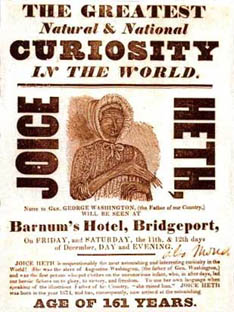While in Europe exotic people were mostly exhibited in zoos, the USA had more traveling circuses. The most successful exhibitor was P.T.Barnum. His career started with exhibiting Joice Heth, an “ex-slave, 161 years of age, who had been the nurse of George Washington – father of the nation.”.P.T. Barnum bought the woman and the show in 1836 from the less successful R.W. Lindsay and made a seven month tour with her until she died. Her weight was only 20 kilos, she was blind and toothless, and extremely wrinkled. She told the public how she had witnessed the birth of little George Washington, how she had fed him and thought him his first songs. The public came to see her, ask questions about little George and touch her.
When she died, she was dissected before a public of 1500 people, on an operating table in the New York City Saloon by doctor David L. Rogers. This experienced surgeon concluded that the woman was 75, or mostly 80 years old. The press was present and concluded that the exhibition of was the most precious scam in American history, having produced at least 10.000 dollars. See the link for details of the dissection on ‘the lost museum’ site about Barnums museum in New York, that burned down in 1865.
Even after the discovery, Barnum did not decline but convinced an editor that the woman on the table was a different woman, and that Joice Heth was somewhere still alive.
In his own memoirs, Barnum admitted that he did not know where the woman had come from and who she was exactly.
Barnum made a long and rich career exhibiting freaks (Tom Thumb, pinheads), ethnic others, animals and en rarities. He was also a politician, author and a gifted speaker. Aged 80, he died in his sleep and was buried at the Bridgeport, Connecticut cemetery that he had designed himself.
It is interesting to see Joice Heths story in the historical context of the struggle for cultural dominance: the show quickly lead to controversy. The high-class press described it as tasteless while an upcoming popular press subscribed its ‘scientific’ importance. This was culture for the people, and the popular culture distinguished itself by principles of equality (between white males) and racism. The principles of a new America – in full North-South struggle – after slavery (abolished in 1865) are designed.
In the book Zoos Humains, Benjamin Reiss writes an engaged chapter about Joice Heth and her historical context.
As in other cases of exhibiting people, a basis is constructed for a scientifically supported widespread popular racism. The white man will no longer be superior to the (ex-)slave for being a slave but for scientific racial reasons. How would that work?


